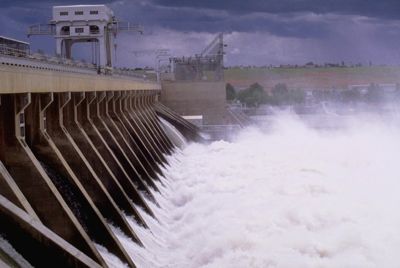forum
library
tutorial
contact

Increasing Salmon Spill at Columbia/Snake Dams;
Science Panel Lists Biological Risks to Aquatic Life
by Staff
Columbia Basin Bulletin, February 21, 2014
|
the film forum library tutorial contact |

|
Increasing Salmon Spill at Columbia/Snake Dams;
by Staff
|
 High levels of spill proposed to whisk migrating juvenile salmon safely down the lower Snake and Columbia rivers in springtime would also pose numerous potential risks to fish and aquatic life, according to a review of the proposal by the Independent Scientific Advisory Board.
High levels of spill proposed to whisk migrating juvenile salmon safely down the lower Snake and Columbia rivers in springtime would also pose numerous potential risks to fish and aquatic life, according to a review of the proposal by the Independent Scientific Advisory Board.
Those ocean-bound salmon and steelhead include hatchery fish as well as naturally born species that are listed under the Endangered Species Act.
The Northwest Power and Conservation Council is required to ask for recommendations from fish and wildlife managers as it works to amend the guiding goals, strategies and principles within its Columbia River Basin Fish and Wildlife Program. That updating process, required by the Northwest Power Act, takes place roughly every five years.
The program guides decisions by the Council on what should be done to mitigate and enhance fish and wildlife populations affected by the construction and operation of the Federal Columbia River Power System. The Bonneville Power Administration, which markets power generated at the federal dams, is charged by the Act with funding mitigation actions proposed through the Council program.
In the most recent go-round, program amendment recommendations were accepted last year by the Council. It is expected to consider recommendations and produce amendments to the program this summer.
Among the recommendations received was a proposal from the state of Oregon, the Nez Perce Tribe, and others that suggests an increase in spring spill levels at each mainstem federal Snake and Columbia River hydropower project up to 125 percent total dissolved gas level in the tailrace of each dam or biological constraints, and then monitor survival effects over ten years compared to the current court-ordered spill program.
State water quality rules now limit TDG levels at a maximum of 120 percent. Elevated gas levels stirred up by water plunging into dam tailraces can negatively affect fish and other aquatic life. On the other hand, many believe that passage through spill gates is less harmful than other passage means, and speeds migration to rates that more closely reflect pre-dam travels.
The ISAB serves the National Marine Fisheries Service (NOAA Fisheries), Columbia River Indian tribes, and the NPCC by providing independent scientific advice and recommendations regarding scientific issues that relate to the respective agencies' fish and wildlife programs.
The Feb. 20 ISAB report can be found at: www.nwcouncil.org/fw/isab/isab2014-2
On Dec.16, the NPCC requested that the ISAB review for scientific merit what is a controversial spill proposal. The ISAB comments will be considered as the Council decides what to include in its new program.
The Council asked that the ISAB consider the following questions:
Potential Biological or Other Risks
Additional Issues
Related Pages:
Increasing Spill at Columbia/Snake Dams: BPA Economic Analysis says $110 Million Annual Loss by Staff, Columbia Basin Bulletin, 2/21/14
Scientists say Oregon's Spill Proposal Not Ready for Prime Time by Bill Rudolph, NW Fishletter, 2/20/14
learn more on topics covered in the film
see the video
read the script
learn the songs
discussion forum
